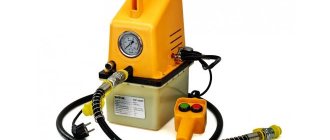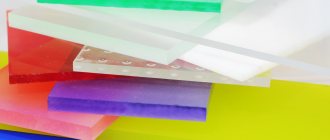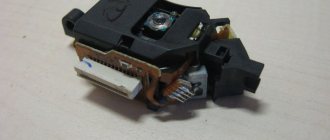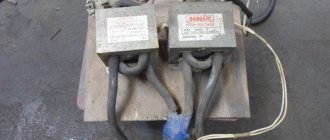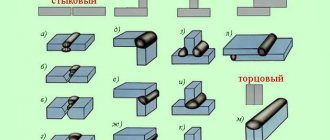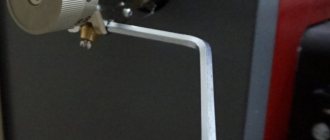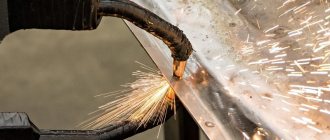Why is it needed?
Along with other semiconductor devices, the LED is not an ideal element with 100% efficiency. Most of the energy it consumes is dissipated into heat. The exact efficiency value depends on the type of emitting diode and its manufacturing technology. The efficiency of low-current LEDs is 10-15%, and for modern white ones with a power of more than 1 W, its value reaches 30%, which means that the remaining 70% is spent as heat.
Whatever the LED, for stable and long-term operation it requires a constant removal of thermal energy from the crystal, that is, a radiator. In low-current LEDs, the radiator function is performed by the leads (anode and cathode). For example, in SMD 2835 the anode lead takes up almost half of the bottom of the element. In high-power LEDs, the absolute value of power dissipation is several orders of magnitude greater. Therefore, they cannot function normally without an additional heat sink. Constant overheating of the light-emitting crystal significantly reduces the service life of the semiconductor device and contributes to a gradual loss of brightness with a shift in the operating wavelength.
Kinds
Structurally, all radiators can be divided into three large groups: plate, rod and ribbed. In all cases, the base can be in the shape of a circle, square or rectangle. The thickness of the base is of fundamental importance when choosing, since it is this area that is responsible for receiving and uniformly distributing heat over the entire surface of the radiator.
The form factor of the radiator is influenced by the future operating mode:
- with natural ventilation;
- with forced ventilation.
A cooling radiator for LEDs that will be used without a fan must have a distance between fins of at least 4 mm. Otherwise, natural convection will not be enough to successfully remove heat. A striking example is the cooling systems of computer processors, where, due to a powerful fan, the distance between the fins is reduced to 1 mm.
When designing LED lamps, great importance is given to their appearance, which has a huge impact on the shape of the heat sink. For example, the thermal energy dissipation system of an LED lamp should not go beyond the standard pear-shaped shape. This fact forces developers to resort to various tricks: using printed circuit boards with an aluminum base, connecting them to the radiator housing using hot-melt adhesive.
Finned radiator
Ribbed (plate) radiator. The area of these radiators is equal to the sum of the areas of all sides. The larger the surface area, the higher the heat transfer efficiency. To improve cooling of the elements, it is necessary to increase the radiator area. And in order not to increase the size, since this is not always possible due to the design of the device, radiators are made with ribs and a microrelief on them. The number of fins and their sizes significantly increase the area of the radiators.
Also, radiators with fins differ in the distance between the fins. On radiators where the distance between them is small, you need to install forced cooling. Such radiators are found in computers to cool processors. Radiators with a large distance between the fins are used without fans. Although the former can also be used without forced cooling. Here you can see how efficiently they will work with and without cooling.
An improved plate heat sink is a set of several plates bent in different directions. This radiator, with a surface area equal to the simplest plate one, has smaller dimensions. This heat sink is installed similarly to a plate heat sink. The number of plates may vary depending on the required surface. The dissipation area of such a radiator is equal to the sum of the areas of all curved sections of the plates, plus the surface area of the central part. This type of radiator also has disadvantages: reduced efficiency of heat removal from all plates, as well as the impossibility of obtaining a perfectly straight surface at the junction of the plates.
Radiator materials
Currently, cooling of high-power LEDs is carried out mainly using aluminum radiators. This choice is due to the lightness, low cost, flexibility in processing and good heat-conducting properties of this metal. Installing a copper radiator for an LED is justified in a luminaire where size is of paramount importance, since copper dissipates heat twice as well as aluminum. Let's consider the properties of materials that are most often used for cooling high-power LEDs in more detail.
Aluminum
The thermal conductivity coefficient of aluminum is in the range of 202–236 W/m*K and depends on the purity of the alloy. According to this indicator, it is 2.5 times higher than iron and brass. In addition, aluminum lends itself to various types of mechanical processing. To increase heat dissipation properties, the aluminum radiator is anodized (coated black).
Copper
The thermal conductivity of copper is 401 W/m*K, second only to silver among other metals. Nevertheless, copper radiators are much less common than aluminum ones, which is due to the presence of a number of disadvantages:
- high cost of copper;
- complex mechanical processing;
- large mass.
The use of a copper cooling structure leads to an increase in the cost of the lamp, which is unacceptable in conditions of fierce competition.
Ceramic
A new solution in creating highly efficient heat sinks has become aluminum nitride ceramics, the thermal conductivity of which is 170–230 W/m*K. This material is characterized by low roughness and high dielectric properties.
Using thermoplastic
Despite the fact that the properties of thermally conductive plastics (3–40 W/m*K) are worse than those of aluminum, their main advantages are low cost and lightness. Many LED lamp manufacturers use thermoplastic to make the housing. However, thermoplastic loses competition to metal radiators in the design of LED lamps with a power of more than 10 W.
Purpose of radiators
The purpose of radiators is to remove heat from semiconductors, this helps reduce the influence of temperature on the operating parameters of devices. For this purpose, plate, fin, and pin radiators are used. The larger the radiator, the better it removes heat from radio components, and thus they heat up less.
To improve heat dissipation, it is best to attach the semiconductor device directly to the radiator. If electrical isolation of the semiconductor device from the chassis is necessary, the radiator is mounted on the chassis through insulating gaskets.
The thermal insulation capacity of a radiator depends on the degree of blackness of the material from which it is made. The more blackness, the more efficient the heat removal will be. Let's look at several types of different radiators to understand which radiator to choose for the semiconductor you need.
There are several technologies for making aluminum radiators. But mainly two technologies are used - casting and extrusion. The choice of radiator production is determined by the question: price - quality. Thus, it is cheaper to make finned radiators using the extrusion method, and needle radiators using the casting method.
For example, ribbed radiators will be cheaper and more efficient when produced by extrusion, but needle-shaped radiators can only be produced by casting.
Cooling features of high-power LEDs
As mentioned earlier, effective heat removal from the LED can be achieved by organizing passive or active cooling. It is advisable to install LEDs with a power consumption of up to 10 W on aluminum (copper) radiators, since their weight and size indicators will have acceptable values.
The use of passive cooling for LED arrays with a power of 50 W or more becomes difficult; The dimensions of the radiator will be tens of centimeters, and the weight will increase to 200-500 grams. In this case, it is worth considering using a compact radiator together with a small fan. This tandem will reduce the weight and size of the cooling system, but will create additional difficulties. The fan must be provided with the appropriate supply voltage, and care must also be taken to protect the LED lamp in the event of a cooler failure.
There is another way to cool powerful LED matrices. It consists of using a ready-made SynJet module, which looks like a cooler for a medium-performance video card. The SynJet module features high performance, a thermal resistance of no more than 2 °C/W and a weight of up to 150 g. Its exact dimensions and weight depend on the specific model. Disadvantages include the need for a power source and high cost. As a result, it turns out that a 50 W LED matrix must be mounted either on a bulky but cheap radiator, or on a small radiator with a fan, power supply and protection system.
Whatever the heatsink, it can provide good, but not the best, thermal contact with the LED substrate. To reduce thermal resistance, heat-conducting paste is applied to the contacted surface. The effectiveness of its impact has been proven by its widespread use in cooling systems for computer processors. High-quality thermal paste is resistant to hardening and has low viscosity. When applied to a radiator (substrate), one thin, even layer over the entire contact area is sufficient. After pressing and fixing, the layer thickness will be about 0.1 mm.
Cooling High Power LEDs
Of course, there is no point in providing LEDs with a power higher than 10 W and lower than 50 W with forced ventilation - radiators made of copper or aluminum can cope with their cooling. But with higher power this becomes problematic. Of course, nothing is impossible, but does it make sense to leave natural cooling at high power of the device if the weight of the cooling device alone is 400 grams or more?
In this case, you will have to think about how to combine a radiator with a small cooler. Of course, this will create some difficulties in terms of power cut-off equipment in the event of a fan failure, as well as its power supply, but it will help reduce the weight of the LED lamp.
It turns out that a person is faced with a choice - either a heavy and bulky, but relatively cheap cooling element, or installing a compact, light-weight radiator with a cooler, power supply and automatic shutdown.
To this we can say that no matter how good the cooling device is, it will not provide ideal thermal resistance. It is precisely to reduce it that special thermal paste is used. Practical experience has proven that it is quite effective, and therefore is used everywhere in computer technology and consumer electronics. If it is of good quality, it will have low viscosity and good resistance to hardening as temperatures rise.
Radiator with cooler
Calculation of radiator area
There are two methods for calculating a radiator for an LED:
- design, the essence of which is to determine the geometric dimensions of the structure at a given temperature;
- calibration, which involves acting in the reverse order, that is, with known radiator parameters, you can calculate the maximum amount of heat that it can effectively dissipate.
The use of one or another option depends on the available initial data. In any case, accurate calculation is a complex mathematical problem with many parameters. In addition to the ability to use reference literature, take the necessary data from graphs and substitute them into the appropriate formulas, you should take into account the configuration of the radiator rods or fins, their orientation, as well as the influence of external factors. It is also worth considering the quality of the LEDs themselves. Often, in Chinese-made LEDs, the actual characteristics differ from the declared ones.
Exact calculation
Before moving on to formulas and calculations, it is necessary to become familiar with the basic terms in the field of thermal energy distribution. Thermal conduction is the process of transferring thermal energy from a more heated physical body to a less heated one. Thermal conductivity is expressed quantitatively as a coefficient that shows how much heat a material can transfer through a unit area when the temperature changes by 1°K. In LED lamps, all parts involved in energy exchange must have high thermal conductivity. In particular, this concerns the transfer of energy from the crystal to the case, and then to the radiator and air.
Convection is also a process of heat transfer that occurs due to the movement of molecules of liquids and gases. In relation to LED lamps, it is customary to consider the exchange of energy between the radiator and the air. This can be natural convection, occurring due to the natural movement of air flow, or forced, organized by installing a fan.
At the beginning of the article it was stated that about 70% of the power consumed by an LED is consumed as heat. To calculate a heatsink for LEDs, you need to know the exact amount of energy dissipated. To do this we use the formula:
PT=k*UPR*IPR, where:
PT – power released in the form of heat, W; k is a coefficient that takes into account the percentage of energy converted into heat. This value for high-power LEDs is taken equal to 0.7-0.8; UPR – forward voltage drop across the LED when the rated current flows, V; IPR – rated current, A.
It's time to count the number of obstacles located in the path of the heat flow from the crystal to the air. Each obstacle represents a thermal resistance, indicated by the symbol (Rθ, degrees/W). For clarity, the entire cooling system is presented in the form of an equivalent circuit of series-parallel connection of thermal resistances
Rθja= Rθjc+ Rθcs+ Rθsa, where:
Rθjc – thermal resistance pn-junction-case; Rθcs – thermal resistance of case-surfase radiator; Rθsa – thermal resistance radiator-air (surfase radiator-air).
If you plan to install an LED on a printed circuit board or use thermal paste, then you also need to take into account their thermal resistance. In practice, the value of Rθsa can be determined in two ways.
Calculate using the formula Rθja=(Tj-Ta)/Pt, where:
Rθja – resistance pn-junction-air; Tj – maximum pn-junction temperature (reference parameter), °C; Ta – air temperature near the radiator, °C.
Rθsa= Rθja-Rθjc-Rθcs, where Rθjc and Rθcs are reference parameters.
Find from the graph “the dependence of the maximum thermal resistance on the forward current.”
Based on the known Rθsa, a standard radiator is selected. In this case, the rated value of thermal resistance should be slightly less than the calculated value.
Approximate formula
Many radio amateurs are accustomed to using radiators left over from old electronic equipment in their homemade products. At the same time, they do not want to delve into complex calculations and buy expensive new imported products. As a rule, they are only interested in one question: “How much power can the existing aluminum LED radiator dissipate?”
We suggest using a simple empirical formula that allows you to obtain an acceptable calculation result: Rθsa=50/√S, where S is the surface area of the radiator in cm2.
Substituting into this formula the known value of the total area of the heat sink, taking into account the surface of the ribs (rods) and side faces, we obtain its thermal resistance.
We find the permissible power dissipation from the formula: Pt=(Tj-Ta)/Rθja.
The above calculation does not take into account many nuances that affect the quality of operation of the entire cooling system (directionality of the radiator, temperature characteristics of the LED, etc.). Therefore, it is recommended to multiply the obtained result by a safety factor of 0.7.
Which radiator to choose
When choosing a radiator, you need to pay attention to many criteria, these are: the material of the radiator, the area of its working surface, the shape of the cooler. All this significantly affects the heat sink characteristics. Cheap aluminum radiators cool worse than copper and graphite radiators, but the latter are also quite expensive. The material from which heatsinks for transistors/LEDs/chips are made is aluminum or copper.
Copper ones are more expensive, but they have better heat dissipation because copper radiators have better thermal conductivity. For example, a heatsink for a processor, a heatsink for a video card and a heatsink for a chipset are better to choose copper-based ones. But it is more advisable to buy radiators for transistors or LEDs based on aluminum (its alloys), because in this case you will get the optimal price/quality ratio.
If you have the opportunity, then buy them in online stores with discounts, or at flea markets. Where prices are much lower than new ones, but the quality is the same.
DIY LED radiator
It’s not difficult to make an aluminum radiator for 1, 3 or 10 W LEDs with your own hands. First, let's look at a simple design, the manufacture of which will take about half an hour and a round plate 1-3 mm thick. Along the circumference, cuts are made to the center every 5 mm, and the resulting sectors are slightly bent so that the finished structure resembles an impeller. To attach the radiator to the body, holes are made in several sectors. It's a little more difficult to make a homemade heatsink for a 10-watt LED. To do this you need 1 meter of aluminum strip 20 mm wide and 2 mm thick. First, the strip is cut with a hacksaw into 8 equal parts, which are then stacked, drilled through and tightened with a bolt and nut. One of the side faces is polished for mounting the LED matrix. Using a chisel, the strips are bent in different directions. Holes are drilled in the places where the LED module is attached. Hot melt adhesive is applied to the sanded surface, a matrix is applied on top, fixing it with self-tapping screws.

